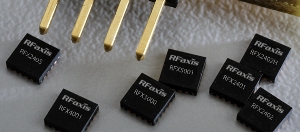Jun 5 2010
Fabless semiconductor company RFaxis, that focuses on state-of-the-art, innovative systems for the connectivity and wireless markets, has announced recently that its novel RF Front-end Integrated Circuits (RFeIC) was qualified to provide best-of-class efficiency and performance for battery-based wireless gadgets even under conditions of ultra-low voltages.
Currently the RFeICs from RFaxis are available for Bluetooth, Zigbee, and WLAN applications are available today, and each one of them can support ultra-low voltages readily.
 RFaxis 2.4GHz, Ultra Low Power, Transmit Receive, Dual Mode WLAN Bluetooth RFeIC
RFaxis 2.4GHz, Ultra Low Power, Transmit Receive, Dual Mode WLAN Bluetooth RFeIC
Dr. Oleksandr Gorbachov, CTO at RFaxis informed that currently every RF front-end solutions operates in the 2.7 and 3.3 volts range, and offers a maximum of 20dBm output power levels with gains in the 18dB to 20dB range for high power Bluetooth and ZigBee applications, along with gains in the 25dB to 30dB range for WLAN applications. He added that these RFeIC gadgets will be able to offer comparable output gains and power levels utilizing a mere 1.5 volt, single cell type of alkaline battery and also operate efficiently with modern portable systems powered by a single fuel cell of 0.8 volt. This renders the RFaxis front-end solutions unbeatable when it relates to the mobile wireless gadgets’ battery efficiency.
RFaxis’ CEO and President Mike Neshat explained that due to an exponential growth in mobile data movement, a new class of ultra-mobile gadgets has attracted the industry. He added that this trend can be overlaid on the all-encompassing requirement for portable wireless gadgets, sensors, controllers along with long functional lives between battery replacement and recharges, making it obvious that the term ‘wireless’ also encompasses battery efficiency and not just portable and mobile connectivity.
He explained that this makes it important to design gadgets that render optimal and efficient usage of current battery solutions, besides advancing the fuel cell and battery technologies. He added that RFaxis’ new generation RF circuit designs and front-end architecture provides its silicon enabled RFeICs an exceptional ability for performing high efficiency and high quality receive and transmit functions at low voltages to facilitate portable wireless gadgets that are long lasting and can operate using a single cell type of alkaline battery also.
Neshat elaborated that considerable environmental advantage is gained by decreasing the number of power of ubiquitous wireless gadgets like building/asset sensors, gaming/remote controllers, headsets, baby monitors, media players, camcorders, and laptops/netbooks/e-readers. He justified that RFaxis is a critical catalyst for the worldwide green revolution. He added that smart energy involves using everyday gadgets to perform clever tasks and not just invent clever devices.